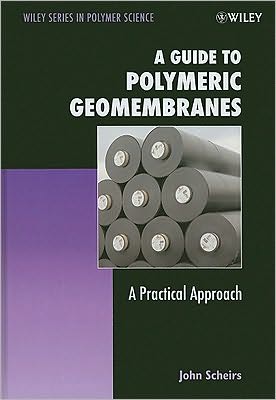

 |

|

Sold Out
Book Categories |
Series Preface.
Preface.
About the Author.
Acknowledgments.
1 Introduction to Polymeric Geomembranes.
1.1 Introduction.
1.2 Viscoelastic Behaviour.
1.3 Polymer Structure.
1.4 Molecular Weight.
1.5 Molecular Weight Distribution.
1.6 Crystallinity.
1.7 Properties of Polyethylenes.
1.8 Stress Strain Behaviour of Polymers.
1.9 Melting Points.
2 Geomembrane Manufacturing Methods.
2.1 Blown Film (Round Die).
2.2 Flat Sheet Extrusion (Flat Die).
2.3 Coextrusion.
2.4 Calendering.
2.5 Spread Coating.
2.6 Extrusion Coated Geomembranes.
2.7 Pin-Hole Detection.
2.8 Texturing.
2.9 Additives for Geomembranes.
3 HDPE Geomembranes.
3.1 Introduction.
3.2 Structure Property Relationships.
3.3 Comparison of HDPE Geomembranes with Other Geomembranes.
3.4 Durability and Survivability of HDPE.
3.5 Selection of Quality HDPE Geomembranes.
3.6 Common Failure Modes of HDPE Geomembranes.
3.7 Multilayer HDPE Geomembranes.
3.8 Fluorinated HDPE (F-HDPE).
4 Linear Low-Density Polyethylene Geomembranes.
4.1 Introduction.
4.2 Attributes of LLDPE Geomembranes.
4.3 Limitations of LLDPE Geomembranes.
4.4 Mechanical Properties.
4.5 LLDPE Geomembrane Resins.
4.6 Speciality Flexible Polyethylene Geomembranes.
4.7 Very Low-Density Polyethylene (VLDPE) Geomembranes.
5 Flexible Polypropylene (fPP) Geomembranes.
5.1 Introduction.
5.2 Attributes of fPP Geomembranes.
5.3 Shortcomings of fPP Geomembranes
5.4 Performance Propeties of fPP Geomembranes.
5.5 Applications.
5.6 fPP Field Failures.
6 CSPE Geomembranes.
6.1 Introduction.
6.2 Grades of Hypalon?.
6.3 Attributes of CSPE Geomembranes.
6.4 Limitations of CSPE Geomembranes.
6.5 General Properties of CSPE Geomembranes.
6.6 Comparisons of CSPE with Other Geomembranes.
6.7 Applications of CSPE Geomembranes.
6.8 Chemical Resistance of CSPE Geomembranes.
7 PVC Geomembranes.
7.1 Introduction.
7.2 Attributes of PVC Geomembranes.
7.3 Shortcomings of PVC.
7.4 Properties of PVC Geomembranes.
7.5 Failure Modes.
7.6 Formulation of PVC Geomembranes.
8 EIA Geomembranes.
8.1 Introduction.
8.2 Attributes of EIA-R Geomembranes.
8.3 Limitations of EIA-R Geomembranes.
8.4 Performance Properties of EIA-R Geomembranes.
8.5 Comparison of EIA-R (XR-5?) Versus CSPE-R (Hypalon?) Geomembranes.
8.6 Application Areas for EIA-R Geomembranes.
9 EPDM Geomembranes.
9.1 Introduction.
9.2 Attributes of EPDM Geomembranes.
9.3 Structure and Chemistry.
9.4 Mechanical Properties.
9.5 Advantages of EPDM over HDPE Geomembranes (Property Comparison).
9.6 Comparison between EPDM and PVC Geomembranes.
9.7 Seaming EPDM Geomembranes.
9.8 Applications.
9.9 Service Life.
10 Bituminous Geomembranes (BGMs).
10.1 Introduction.
10.2 Prefabricated Bitumen Membranes.
10.3 Composition and Construction.
10.4 Longevity of Bituminous Geomembranes.
10.5 Spray-in-Place Bitumen Membranes.
10.6 Design Life of Bituminous Geomembranes.
11 Specialty Geomembranes and Liners.
11.1 EVA Liners/Geomembranes.
11.2 Butyl Rubber Liners.
11.3 Nitrile Rubber Geomembranes.
11.4 Chlorinated Polyethylene (CPE).
11.5 Polyurethane (PU) Geomembranes.
11.6 Acrylic-Coated Geomembranes/Geotextile Composites.
11.7 PVDF Liners.
11.8 Chemical Vapour Barrier Membranes.
12 Key Performance Properties of Geomembranes.
12.1 Specific Gravity (Density).
12.2 Mass per Unit Area.
12.3 Thickness.
12.4 Melting Point.
12.5 Melt Flow Index.
12.6 Thermal Expansion.
12.7 Flexibility.
12.8 Conformability for Intimate Contact.
12.9 Ability to Resist/Accept Stress and Deformation.
12.10 Tensile Properties.
12.11 Puncture Resistance.
12.12 Tear Resistance.
12.13 Ply Adhesion of Reinforced Geomembranes.
12.14 Resistance to Stress Cracking.
12.15 Frictional Properties.
12.16 Low-Temperature Properties.
12.17 High-Temperature Capabilities.
12.18 Oxidative Resistance.
12.19 UV Resistance.
12.20 Permeability of Geomembranes.
12.21 Durability.
12.22 Application Specific Performance Properties.
12.23 Comparison of Performance Properties of Flexible Geomembranes.
13 Testing of Geomembranes.
13.1 Material Property Testing.
13.2 Measuring Thickness.
13.3 Density.
13.4 Mass per Unit Area.
13.5 Tensile Testing Methods.
13.6 Tear Testing.
13.7 Ply Adhesion.
13.8 Puncture Resistance.
13.9 Impact Resistance.
13.10 Environmental Stress Cracking.
13.11 Dimensional Stability.
13.12 Friction Angles.
13.13 Melt Flow Index (MFI).
13.14 Durability Testing.
13.15 Tests for Additives.
13.16 Carbonyl Index Measurements.
13.17 Chemical Resistance Testing.
14 Chemical Resistance of Geomembranes.
14.1 Chemical Resistance Tables.
14.2 Factors Affecting Chemical Resistance.
14.3 Effects of Chemicals on Geomembranes.
14.4 Chemical Resistance Testing.
14.5 Geomembrane Chemical Resistance by Chemical Class.
14.6 Geomembrane Chemical Resistance by Polymer Type.
14.7 Environmental Stress Cracking.
15 Failure Modes of Geomembranes.
15.1 Potential for Geomembrane Damage.
15.2 Failure of Installed Geomembranes.
16 Application Areas for Geomembranes.
16.1 Landfill Liners.
16.2 Landfill Caps/Covers.
16.3 Mining Applications.
16.4 Floating Covers.
16.5 Tank Liners.
17 Welding of Geomembranes.
17.1 Wedge Welding.
17.2 Hot Air Fusion Welding.
17.3 Extrusion Welding.
17.4 General Overview of Thermal Welding Methods.
17.5 Potential Thermal Welding Problems.
17.6 Defects that can Affect Weld Integrity.
17.7 Trial Welds and Field Welds.
17.8 Chemical Welding of Geomembranes.
17.9 General Welding Instructions for HDPE/LLDPE/fPP Geomembranes.
17.10 General Welding Instructions for PVC Geomembranes.
18 Geomembrane Weld Testing Methods.
18.1 Introduction to Weld Testing.
18.2 Visual Inspection of Welds.
18.3 Nondestructive Seam Tests.
18.4 Destructive Weld Tests.
18.5 Forensic Weld Examination.
18.6 Leak Location Testing.
19 Geomembrane Installation Factors.
19.1 Introduction.
19.2 Design Considerations.
19.3 Installation and Damage Considerations.
Appendix 1 Glossary.
Appendix 2 Geomembrane Test Methods.
American Society for Testing and Material.
Geomembrane (GM) Related Test Methods and Standards from GRI.
Geomembrane Testing Methods Conversion Table ASTM and ISO.
Index.
Login|Complaints|Blog|Games|Digital Media|Souls|Obituary|Contact Us|FAQ
CAN'T FIND WHAT YOU'RE LOOKING FOR? CLICK HERE!!! X
 You must be logged in to add to WishlistX
 This item is in your Wish ListX
 This item is in your CollectionA Guide to Polymeric Geomembranes: A Practical Approach
X
 This Item is in Your InventoryA Guide to Polymeric Geomembranes: A Practical Approach
X
 You must be logged in to review the productsX
 X
 X

Add A Guide to Polymeric Geomembranes: A Practical Approach, Geomembranes are flexible polymeric sheets which are used as relatively impermeable liners to contain liquid and vapour. With uses ranging from canal liners to hazard waste landfills, they are used extensively in a range of industries such as water conser, A Guide to Polymeric Geomembranes: A Practical Approach to the inventory that you are selling on WonderClubX
 X

Add A Guide to Polymeric Geomembranes: A Practical Approach, Geomembranes are flexible polymeric sheets which are used as relatively impermeable liners to contain liquid and vapour. With uses ranging from canal liners to hazard waste landfills, they are used extensively in a range of industries such as water conser, A Guide to Polymeric Geomembranes: A Practical Approach to your collection on WonderClub |